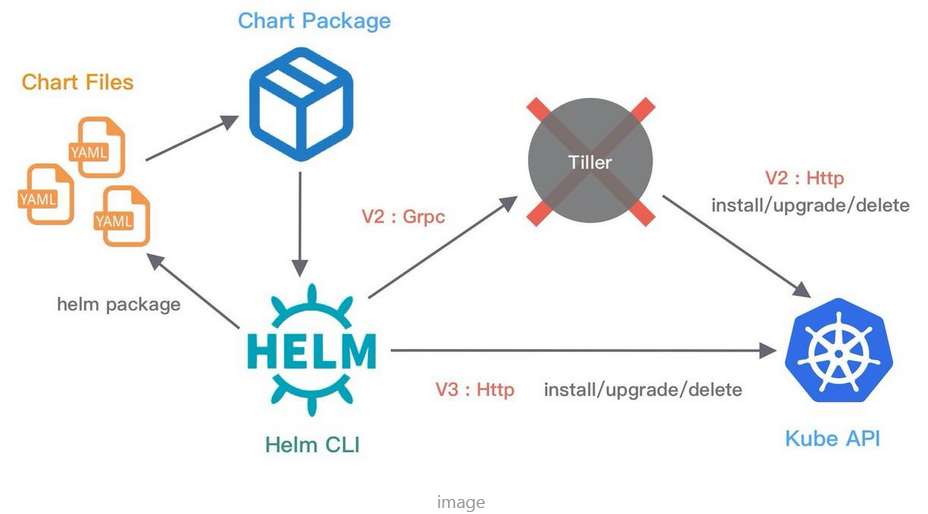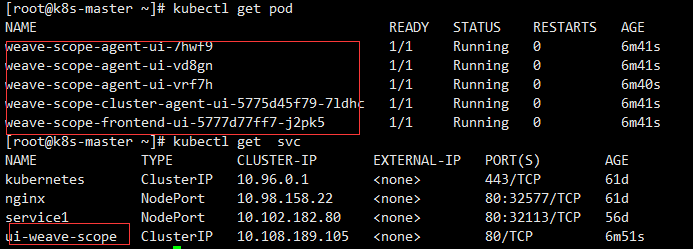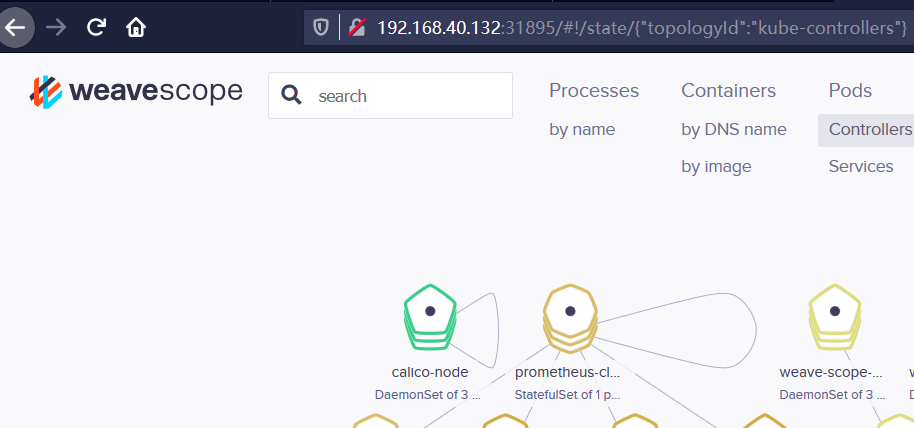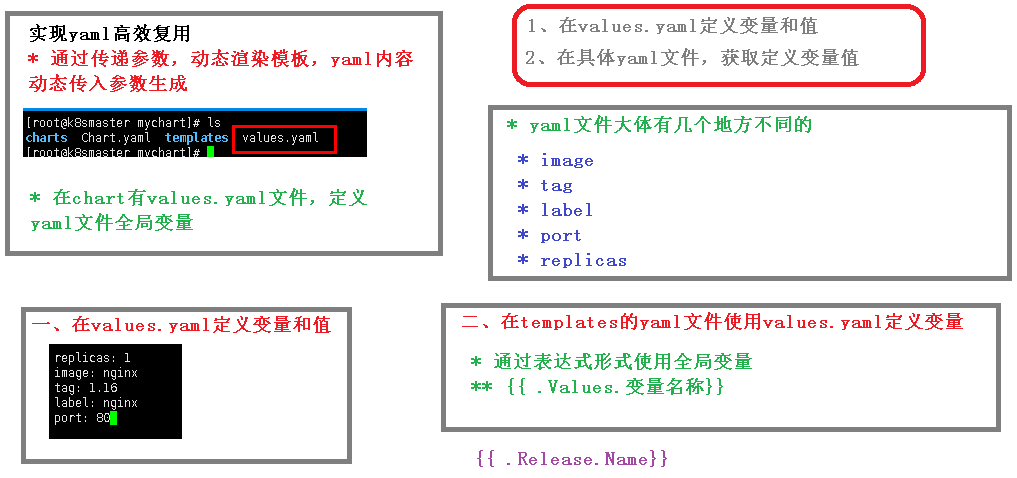一、helm的引入
当应用太多,yaml文件多、杂,管理和维护成本加重。引入helm包管理器,chart打包一堆yaml文件,统一部署。
二、名词概念
Chart
打包到一起的一堆yaml文件,即k8s资源集合
Config
Config 指应用配置参数,在 Chart 中由 values.yaml 和命令行参数组成。Chart 采用 Go Template 的特性 + values.yaml 对部署的模板文件进行参数渲染,也可以通过 Helm Client 的命令
--set key=value 的方式进行参数赋值。
Repository
类似于 Docker Hub,Helm 官方、阿里云等社区都提供了 Helm Repository,我们可以通过 helm repo add 导入仓库地址,便可以检索仓库并选择别人已经制作好的 Chart 包,开箱即用。
Release
Release 代表 Chart 在集群中的运行实例,同一个集群的同一个 Namespace 下 Release 名称是唯一的。Helm 围绕 Release 对应用提供了强大的生命周期管理能力,包括 Release 的查询、安装、更新、删除、回滚等。
Tiller(v3版本中已去除)
helm的服务端,用 Go 编写。它提供了一个与客户端连接的 gRPC 服务,它使用 Kubernetes 客户端库与 Kubernetes 进行通信。目前,该库使用 REST + JSON。
Tiller 服务将信息存储在位于 Kubernetes 内的 ConfigMaps 中,它不需要自己的数据库。
三、helm的优点
1、实现把yaml文件整体管理;
2、yaml文件高效复用;
3、应用级别的版本管理;
四、v3与v2的架构变化
1、最大的改动就是移除了 Tiller 组件,所有功能都通过 Helm CLI 与 ApiServer 直接交互。
2、release在v3版本中可以实现不同的namespace空间中重用;
3、可以将chart推入到docker仓库中。

五、helm v3的安装
v3的安装比v2简单快捷,不需要做授权操作,将二进制可执行文件放入到/usr/bin/即可
wget https://get.helm.sh/helm-v3.2.1-linux-amd64.tar.gz && tar xzvf helm-v3.2.1-linux-amd64.tar.gz -C /usr/loca/src && sudo mv /usr/local/src/linux-amd64/helm /usr/local/bin/
1、官网 https://helm.sh/docs/
2、解压安装
# tar zxvf helm-v3.0.0-linux-amd64.tar.gz
# cd linux-amd64/
# ls
helm LICENSE README.md
# mv helm /usr/bin/
# helm version
version.BuildInfo{Version:"v3.0.0", GitCommit:"e29ce2a54e96cd02ccfce88bee4f58bb6e2a28b6", GitTreeState:"clean", GoVersion:"go1.13.4"}
3、配置helm仓库
https://help.aliyun.com/document_detail/131467.html helm使用阿里私有仓库
添加公有仓库如下 # helm repo add apphub https://apphub.aliyuncs.com 添加Helm Hub “中国站” "apphub" has been added to your repositories # helm repo add stable https://kubernetes.oss-cn-hangzhou.aliyuncs.com/charts "stable" has been added to your repositories # helm repo list NAME URL apphub https://apphub.aliyuncs.com (apphub和stable是自定义repo名称) stable https://kubernetes.oss-cn-hangzhou.aliyuncs.com/charts
移除和更新仓库
helm repo remove 仓库名 helm repo update Hang tight while we grab the latest from your chart repositories... ...Successfully got an update from the "apphub" chart repository ...Successfully got an update from the "stable" chart repository Update Complete. ⎈ Happy Helming!⎈
search搜索应用(指定repo所有仓库)
# helm search repo weave
NAME CHART VERSION APP VERSION DESCRIPTION
apphub/weave-cloud 0.3.7 1.4.0 Weave Cloud is a add-on to Kubernetes which pro...
apphub/weave-scope 1.1.8 1.12.0 A Helm chart for the Weave Scope cluster visual...
stable/weave-cloud 0.1.2 Weave Cloud is a add-on to Kubernetes which pro...
stable/weave-scope 0.9.2 1.6.5 A Helm chart for the Weave Scope cluster visual...
# helm search repo ${keyword} 查看所有的资源
helm安装搜索的某个应用
# helm install ui apphub/weave-scope (ui自己取的名称)
NAME: ui
LAST DEPLOYED: Tue Sep 22 22:36:12 2020
NAMESPACE: default
STATUS: deployed
REVISION: 1
NOTES:
You should now be able to access the Scope frontend in your web browser, by
using kubectl port-forward:
kubectl -n default port-forward $(kubectl -n default get endpoints
ui-weave-scope -o jsonpath='{.subsets[0].addresses[0].targetRef.name}') 8080:4040
then browsing to http://localhost:8080/.
For more details on using Weave Scope, see the Weave Scope documentation:
https://www.weave.works/docs/scope/latest/introducing/

修改ClusterIP为NodePort,部署成功。

查看安装后的状态
# helm list
NAME NAMESPACE REVISION UPDATED STATUS CHART APP VERSION
ui default 1 2020-09-22 23:03:12.207890113 +0800 CST deployed weave-scope-1.1.8 1.12.0
# helm status ui
NAME: ui
LAST DEPLOYED: Tue Sep 22 23:03:12 2020
NAMESPACE: default
STATUS: deployed
REVISION: 1
NOTES:
You should now be able to access the Scope frontend in your web browser, by
using kubectl port-forward:
kubectl -n default port-forward $(kubectl -n default get endpoints
ui-weave-scope -o jsonpath='{.subsets[0].addresses[0].targetRef.name}') 8080:4040
then browsing to http://localhost:8080/.
For more details on using Weave Scope, see the Weave Scope documentation:
https://www.weave.works/docs/scope/latest/introducing/
六、自定义chart
1、生成一个chart模板
# helm create ./chart-demo Creating ./chart-demo # cd chart-demo/ # ls charts Chart.yaml templates values.yaml 注:templates里面存放自己的yaml文件 values.yaml存放全局变量,用于yaml的高复用 Chart.yaml用来定义一些chart的属性
2、在templates 里面存放自己的yaml文件
3、安装自定义chart
heml install web mychart/
4、升级
heml upgrade mychart/ helm upgrade cloude-native-gitlab --values values.yaml gitlab-offical/gitlab
5、查看release列表
helm list --namespace ${namespace}
七、chart资源的高复用
传递参数,动态渲染模板,yaml的内容通过传参生成
修改values.yaml文件,{{ .Release.Name}} {{ .Values.变量名}}

还有待学习领悟
八、chart包管理
# 本地创建一个 Chart helm create <Chart 名称> // 安装helm-push插件,可能会卡 [root@master01 msxu]# helm plugin install https://github.com/chartmuseum/helm-push.git # 推送 Chart 目录 helm push <Chart 名称> <本地仓库名称> # 或者推送 Chart 压缩包 helm push <Chart 名称>-<Chart 版本>.tgz <本地仓库名称> # 从线上 Chart 仓库更新本地 Chart 索引 helm repo update # 拉取 Chart helm fetch <本地仓库名称>/<Chart 名称> --version <Chart 版本> # 或者直接安装 Chart helm install -f values.yaml <本地仓库名称>/<Chart 名称> --version <Chart 版本>
https://www.jianshu.com/p/11828ace23f9
https://www.cnblogs.com/pythonPath/p/12667509.html 新工具kustomize
https://segmentfault.com/a/1190000022583522?utm_source=tag-newest
https://github.com/bitnami/charts/tree/master/bitnami 一个不错的heml仓库